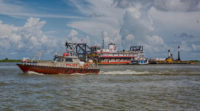The Los Angeles County Board of Supervisors on June 14 unanimously approved an ambitious plan to revitalize the Los Angeles River, despite the withdrawn support of several environmental and community groups. The plan is intended to serve as a blueprint to transform the river into a public open space and natural urban habitat over the next quarter-century.
The Los Angeles River Master Plan—which took six years to develop—identifies strategies, programs, and project opportunity sites to restore the waterway, and address related housing issues and community impacts.
County officials estimate that implementing all of the projects included in the plan would cost between $19 billion and $24 billion.
“I believe we have accomplished our goal in developing the LA River Master Plan, which was to pool resources from across the region to not only reinvest in this critical piece of infrastructure but also to ensure that residents do not get displaced in order to benefit from improvements along the river,” said Los Angeles County Supervisor Hilda L. Solis.
Adoption of the master plan sets standards and conditions for activities and projects affecting the river and provides guidance to planand design improvements to the waterway. The board ordered creation of an implementation team formed from 10 county departments involved in the plan that will coordinate adoption of the plan and help prioritize projects to develop.
The 51-mile river begins in Canoga Park northwest of Los Angeles. It then crosses through more than a dozen cities on its course to Long Beach, where it empties into the Pacific Ocean. Almost the entire alignment of the river is paved in concrete as part of channelization efforts to control flooding.
The river corridor includes more than 2,300 acres of publicly-owned land. Nearly one million people live within a mile of the waterway.
The original river master plan was drafted in 1996 with the goal of improved flood abatement and beautification. In 2016, country supervisors launched an update to the plan that expanded original goals and addressed needs of the communities along the river.
Over the next several years, the new plan was developed by a 41-member steering committee, and included more than a dozen public community meetings and 15 events coordinated with 10 community organizations. A revised draft of the master plan was presented in January 2021.
The new plan is greatly expanded in scope and aims to improve water quality and increase wildlife habitat and diversity. It includes building a trail along the entire course of the waterway and improving public access to its parks.
Portions of the plan include enormous elevated platform parks designed by architect Frank Gehry that would create green spaces supported over the bed of the channel, which would remain concrete-clad. The plan also calls for creation of cultural centers along the river's route to benefit adjacent communities.
Immediately prior to the board’s vote, several environmental groups that had participated in plan development sent a letter to the county dropping their support.
“The final Plan wholly ignores the many comments that non-profit and community-based organizations raised during the drafting process, and falsely claims that the Plan engaged in robust community engagement and reflects feedback from members of the Steering Committee,” the letter states.
The group accused the master plan of treating the river as “nothing more than a flood control channel,” which did not seriously consider efforts to remove concrete lining the channel and remediate the contaminated land.
Additionally, concerns have been raised that the improvements outlined by the plan will lead to gentrification of communities along the waterway. To account for that, plan elements are aimed at mitigating housing shortages and addressing concerns about the lack of affordable housing in the area along the river’s course.
During the June 14 meeting, the county board also requested information on creation of a land bank pilot program to address affordable housing infrastructure, with a particular focus on areas along the Los Angeles River.





Post a comment to this article
Report Abusive Comment